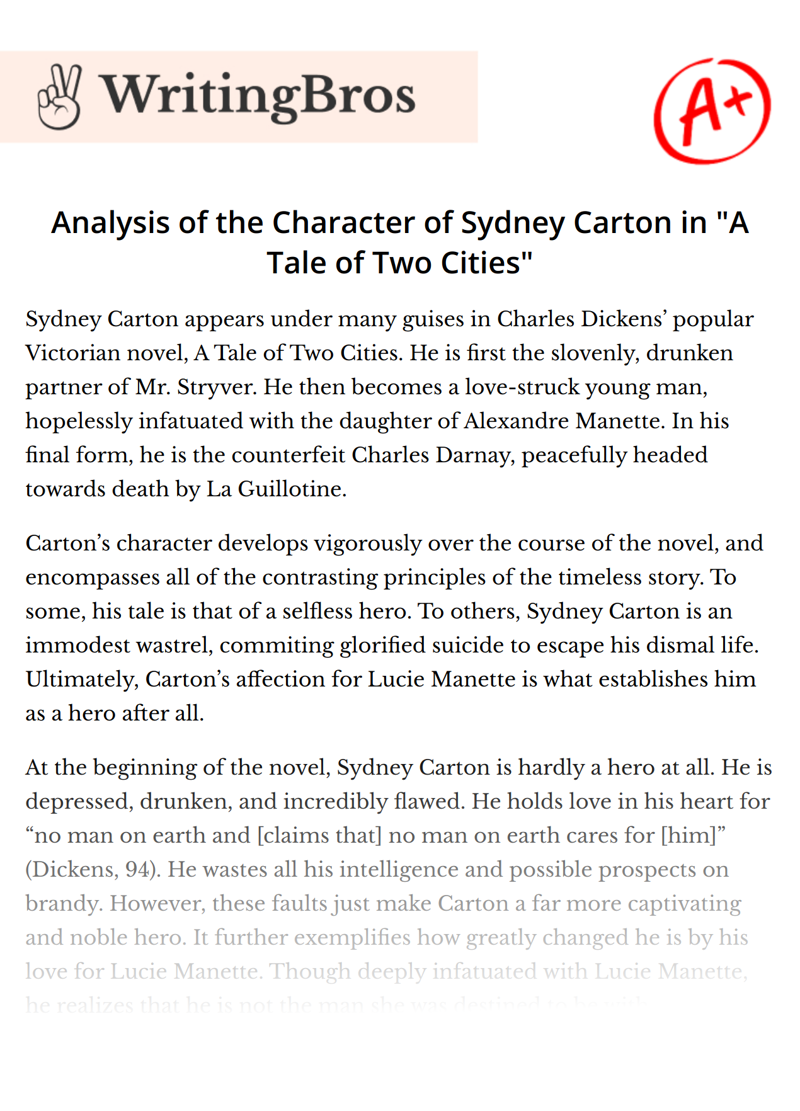Analysis of the Character of Sydney Carton in "A Tale of Two Cities"

Sydney Carton appears under many guises in Charles Dickens’ popular Victorian novel, A Tale of Two Cities. He is first the slovenly, drunken partner of Mr. Stryver. He then becomes a love-struck young man, hopelessly infatuated with the daughter of Alexandre Manette. In his final form, he is the counterfeit Charles Darnay, peacefully headed towards death by La Guillotine.
Carton’s character develops vigorously over the course of the novel, and encompasses all of the contrasting principles of the timeless story. To some, his tale is that of a selfless hero. To others, Sydney Carton is an immodest wastrel, commiting glorified suicide to escape his dismal life. Ultimately, Carton’s affection for Lucie Manette is what establishes him as a hero after all.
At the beginning of the novel, Sydney Carton is hardly a hero at all. He is depressed, drunken, and incredibly flawed. He holds love in his heart for “no man on earth and [claims that] no man on earth cares for [him]” (Dickens, 94). He wastes all his intelligence and possible prospects on brandy. However, these faults just make Carton a far more captivating and noble hero. It further exemplifies how greatly changed he is by his love for Lucie Manette. Though deeply infatuated with Lucie Manette, he realizes that he is not the man she was destined to be with.
He knows that he would “pull [her] down with him” (Dickens, 171), and willingly rids himself as a potential suitor. However, he still earnestly assures Lucie that he would “give his life to keep a life [she] love[s] beside [her]” (Dickens, 174). Carton’s heroism appears in this sacrifice. Not only is he forgoing the woman he loves, but he is also watching her marry the man he could have been, simply because he knows it is what would be best for her. His actions here cause himself great injury in order to ensure Lucie’s happiness.
Through his love for Lucie, Carton’s strength and fortitude continue to blossom. His bravery is truly tested when Charles Darnay, Lucie’s husband, is sentenced to death for being born in the French aristocracy. In an attempt to save Lucie from being widowed, Carton resolves that he must fulfill his earlier promise. He must trade his life for one that Lucie loves. Carton trades places with Darnay in his cell and is soon making a journey to La Guillotine. As he stands, approaching his imminent death, Carton continues to act selflessly.
He spends his last few words comforting a young seamstress also condemned to die. When Sydney Carton lays down his life for Lucie Manette, he believes that it is a “far better thing [he] does, than [he] has ever done” (Dickens, 385). When he meets his end, he “see[s] the lives for which [he] lay[s] down his life” (Dickens, 385) and feels nothing but peace for the family he has saved. Though he never receives any recompense for his actions, Carton makes the ultimate sacrifice for the Manettes. He selflessly enters their lives alone, and exits alone on the steps of La Guillotine. His bloodstain on the pavement of those Parisian streets forever immortalizes him as a hero in the lives of all who knew him.
However, others who have read this tale claim that Sydney Carton’s deeds are anything but heroic. They claim that his death is glorified suicide, the eventual end to a depressed and drunken man. Due to his depressive state and empty life, his actions could hardly be classified as heroic. However, there is no logic to these claims. Though Carton has spent many years wasting his days drinking, by the time he is standing on the steps of La Guillotine, his life finally has purpose. He is deeply in love with Lucie Manette. If it were not for her suffering, Carton would not willingly die. In fact, it is very clear that throughout the end of the book, Carton is in a far improved state than he was in the beginning of the book.
Why would a man so improved wish for death? Carton is not trying to escape his miserable life, he merely realizes that in exchange for his life, a new family can continue to prosper in England, safe from the radicalism that has taken power in France. In Carton’s mind, there is only peace and absolute pride in this decision, not misery. His sacrifice speaks for itself, and the selfless, brave man he was. Would a selfish wastrel be held “honored and held sacred” (Dickens, 385) in the lives of many?
Through his sacrifice, Carton’s life is redeemed from the miserable and lonesome life it started as. Carton exemplifies that any ordinary person can become an unlikely hero and save the day. The theme of redemption is exemplified in Sydney Carton’s sacrificial death. Carton’s death redeems his wasted life, giving purpose to his existence. From his death, Lucie will bear a child with his name, “winning his way up in the path of life that was [Carton’s]” (Dickens, 388). This theme is prevalent in many other facets of Dickens’ classic tale. It is first introduced as Dr. Manette returning to life after his eighteen year long imprisonment in the Bastille.
It is presented again, this time under the humourous workings of Jerry Cruncher, who ‘revives’ the dead through his grave digging. Lastly, Charles Darnay is redeemed from disgrace three times in the novel, as he is imprisoned and made an outcast from society by both the English and French governments. It takes Carton’s death alone to redeem the life of Charles Darnay, an action which makes him in the eyes of all, an undoubted hero.
Cite this Essay
To export a reference to this article please select a referencing style below

